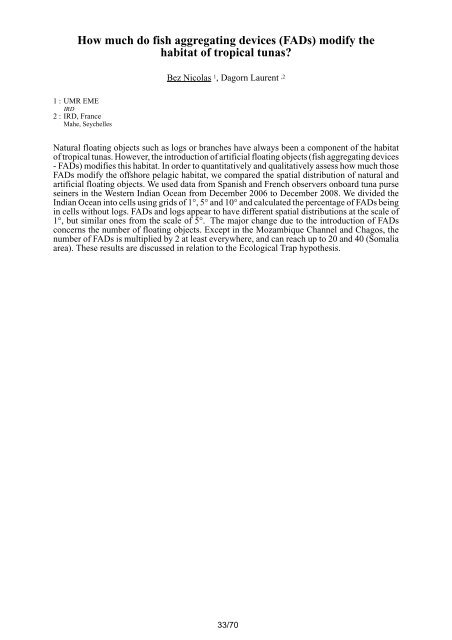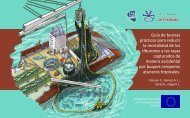Create successful ePaper yourself
Turn your PDF publications into a flip-book with our unique Google optimized e-Paper software.
How much do fish aggregating devices (FADs) modify the<br />
habitat <strong>of</strong> tropical tunas?<br />
1 : UMR EME<br />
IRD<br />
2 : IRD, France<br />
Mahe, Seychelles<br />
Bez Nicolas 1, Dagorn Laurent ,2<br />
Natural floating objects such as logs or branches have always been a component <strong>of</strong> the habitat<br />
<strong>of</strong> tropical tunas. However, the introduction <strong>of</strong> artificial floating objects (fish aggregating devices<br />
- FADs) modifies this habitat. In order to quantitatively and qualitatively assess how much those<br />
FADs modify the <strong>of</strong>fshore pelagic habitat, we compared the spatial distribution <strong>of</strong> natural and<br />
artificial floating objects. We used data from Spanish and French observers onboard tuna purse<br />
seiners in the Western Indian Ocean from December 2006 to December 2008. We divided the<br />
Indian Ocean into cells using grids <strong>of</strong> 1°, 5° and 10° and calculated the percentage <strong>of</strong> FADs being<br />
in cells without logs. FADs and logs appear to have different spatial distributions at the scale <strong>of</strong><br />
1°, but similar ones from the scale <strong>of</strong> 5°. The major change due to the introduction <strong>of</strong> FADs<br />
concerns the number <strong>of</strong> floating objects. Except in the Mozambique Channel and Chagos, the<br />
number <strong>of</strong> FADs is multiplied by 2 at least everywhere, and can reach up to 20 and 40 (Somalia<br />
area). These results are discussed in relation to the Ecological Trap hypothesis.<br />
33/70




